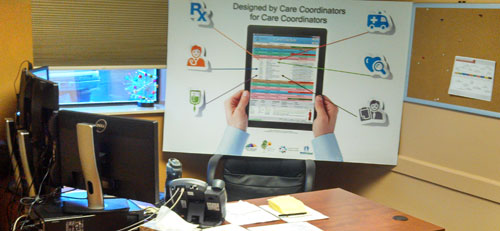For more than two years I’ve witnessed firsthand the evolution of healthcare via skunk works in Southern Colorado. The concept seemed simple enough. The need to coordinate care for clients between multiple agencies. With enough familiarity with the local resources that are available to guide, to “navigate”, to council medicaid members through their care decisions they’ll justify the extra effort in reducing waste from a few key areas. It seemed simple.
“I felt a bit like Noah suggesting that we build an ark.”
“The missing link in this evolution was the tool. EHR [Electronic Health Record] software is designed to document treatment from a limited and pretty specific list of specialties. Care coordination is an entirely different thing. Purposely broad and general in nature. I felt a bit like Noah suggesting that we build an ark. When the state seems to be suggesting that they are going to flood your organization with 100,000 new responsibilities a sense of urgency is an understatement. We panicked a bit in a very good way. Two years ago we panicked. Now it’s raining and we’re enjoying the rain. We didn’t misinterpret the signs. We’ve hit 60,000 members in January and that population is growing weekly. So far our ark is holding up.”
That “ark” is an application that Spanish Peaks refers to as an integrated health registry (IHR).
“We originally just called it ‘the care coordination application’ internally, and then we called it ‘CareTracker’ until we discovered there was already an EHR of the same name and we were even using that EHR at one of our centers!”
Now they call it an integrated health registry. Whatever they call it the functions are crucial to the management of a large influx of members and needs.
“Just like Noah, we haven’t gotten to this point without our share of detractors. Now some of them are standing in the rain and still shaking their fists, pleading ignorance, and rationalizing their strategies. When the state gives us two years’ notice that our entire medicaid population is going to transition into a new model of accountable and integrated care, it’s imperative that we adapt.”
Adapt they did, and only now is the necessity of their new tool becoming evident. Spanish Peaks has now dedicated a large portion of a building and more than a handful of FTEs to this effort. Their jobs are somewhere between RN, social worker, and telemarketer. The contact management data they require and collect is just such a different schema from care-oriented electronic health record software.
“You can try to store your eggs in the cookie jar with the cookies, but it won’t be very efficient.”
“We realized early on that trying to use an EHR to do integrated care would be like trying to jam a square peg into a round hole. There are names and addresses, basic demographics like any system, but beyond that one needs to get far too creative to justify creating bogus treatment plans, placeholder services, and then tripping through the clumsy process all that would necessitate. You can try to store your eggs in the cookie jar with the cookies, but it won’t be very efficient.”
Spanish Peaks Behavioral Health Centers of Southern Colorado have leveraged technology effectively to perfect integrated care coordination through their integrated health registry program. When asked about the technology:
“We’re mostly a Microsoft shop, and we’ve combined a few key products in an unconventional way. Not the expensive products either. This effort cost the organization nothing in new licensing.”
When pressed further, one of the developers admitted with a smirk:
“I didn’t say it was entirely Microsoft. I said mostly. So 51% or so, make of that what you want. We’ve had to roll with a lot of punches, so this thing had to be fantastically flexible, but also functionally concise. We’re back to not even knowing what to call it, but in my 20 years of software development I’ve never seen a system architecture quite like this. It is quite literally infinitly flexible, without being cumbersome. That’s a tough balance to maintain on top of the rigorous security requirements.”
I got a peek at their system and it is quite unique. The user interface looked more like a colorful PDF report than an average windows application. Yet tap elements in the report and the magic begins. On the Windows Surface tablet I was using – rumor has it it works on iPads too – the gestures and format were very intuitive. A drill-down report that was literally a robust interface to a full featured IHR (Integrated Health Registry), or whatever they decide to call it next month. Leadership in Integrated Care coming from a rural area of Southern Colorado. Newsworthy.
-Josh

We have need for this for our big client. I email. Our company is 70 programmers and our client one top insurance that want us to do this for them. They will want Oracle database. Is that a problem?
Rupesh, I’ve forwarded your email. I don’t believe their goal is to sell the program. Their goal is to do Integrated Care as efficiently as possible.